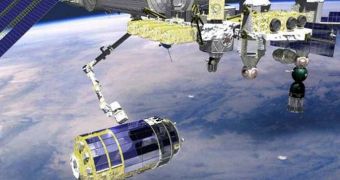At around 6:44 am EST (1144 GMT), the crew of the International Space Station (ISS) is expected to make contact with a newly-launched Japanese resupply spacecraft. The cargo ship has been tracking the lab in orbit for several days, and it's only today that it will finally manage to catch up with it.
The H-II Transfer Vehicle (HTV2) is dubbed Kounotori 2, and it is scheduled to arrive early in the morning of January 27. This is the second unmanned cargo ship that the Japanese launched since they began the HTV program, a couple of years ago.
As the craft is approaching the ISS, the six permanent residents on the orbital facility, all of them astronauts with Expedition 26, are getting ready to grapple the container using the Canadarm2 robotic arm aboard the station.
Since the HTV series does not feature automated docking controls, spacecraft cannot maneuver to docking berths on their own. So their manufacturers opted for a docking method in which astronauts have to play orbital cowboys.
As the spacecraft reach the ISS in orbit, they are set on a course that would normally take them right past the outpost, and then further on their way. The time the HTV spent around the ISS is usually no longer than 90 seconds.
This is precisely how much time two astronauts on the station have to use the robotic arm to grapple the HTV. Once this is accomplished, the cargo vehicle is maneuvered to its correct docking berth.
Astronauts then unload its cargo, which consists of personal items, food, water, propellant for the station's orbital maneuvering thrusters, scientific experiments and space parts. When this is done, they begin loading the container up with garbage and used items.
Kounotori 2 took off from the Tanegashima Space Center at 2:37 pm Japan Standard Time (0537 GMT) on January 22. It was delivered to low-Earth orbit (LEO) aboard an H-2B heavy-lift rocket.
The delivery system was developed by the Japanese Aerospace Exploration Agency and Mitsubishi Heavy Industries, while the spacecraft itself was designed and developed by JAXA.
HTV2 “has been flying smoothly, and it is gradually approaching the International Space Station through an altitude control maneuver,” JAXA officials said in a statement they gave recently.
The Japanese HTV, the European ATV, and the Russian Progress spacecraft will form the fleet that will resupply the ISS beginning this July, when the last shuttle flight is currently scheduled to take place.
Carrying astronauts to orbit will only be possible aboard Russian-built Soyuz space capsules, Space reports.

 14 DAY TRIAL //
14 DAY TRIAL //